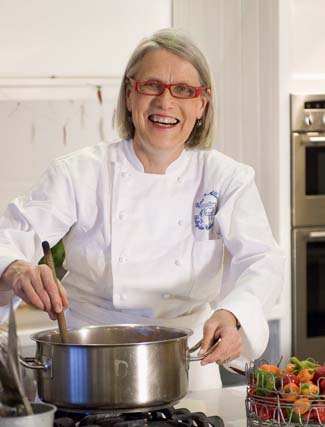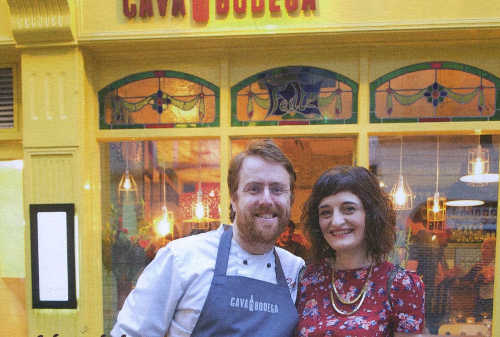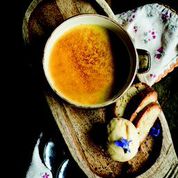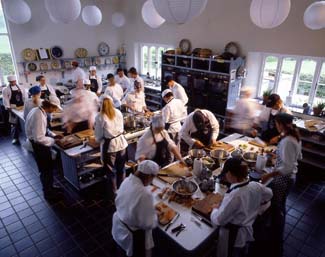The Darina Allen Column

This month Darina talks about one of the West of Ireland’s biggest food heroes, JP McMahon. The larger than life author of ‘Cava Bodega Tapas, A Taste of Spain in Ireland’ is a speaker at this year’s Kerrygold Ballymaloe Lifest LitFest (15-17 May 2015)
Chef-owner of the much-feted Aniar restaurant in Galway, JP McMahon keeps a lot of balls in the air. He is culinary director of the EatGalway Restaurant Group, made up of Aniar, Cava Boedga, and Eat Gastropub, plus he runs the Aniar Boutique Cookery School.
He is totally committed to local producers and engages directly with small farmers. That’s not all, he is the founding chair and director of the Galway Food Festival and is an ambassador for Irish food.
In his spare time JP also lectures in Art History in UCC and is currently finishing his PhD and can you imagine on top of all that JP is organising an international chef symposium entitled 'Food on the Edge' which will take place in Galway in October 2015.
WOW, I’m exhausted from even reading this and there’s more, when does this boy sleep! Most recently, he has self-published a book ‘Tapas, A Taste of Spain in Ireland’, The recipes are from Cava Bodega, the much loved tapas restaurant he and his wife Drigín opened in Dominick Street in Galway in 2008.
 JP and Drigín love Spain. There’s always been a strong link between Ireland and Spain, and Galway in particular, dating back to 500 B.C. The trading ships would come into Galway Bay and sail right up to what is now called the Spanish Arch, home of another of my favourite Galway eateries, Ard Bia.
JP and Drigín love Spain. There’s always been a strong link between Ireland and Spain, and Galway in particular, dating back to 500 B.C. The trading ships would come into Galway Bay and sail right up to what is now called the Spanish Arch, home of another of my favourite Galway eateries, Ard Bia.
JP has a deep a love for Spanish food and culture. The recipes for the para picar (nibbles) tapas (small bites) and pinchos (a larger version) in the book reflect his interpretation of the Hiberno-Spanish version of many classic and contemporary dishes.
JP is also an ambassador for the “Cook It Raw” movement started by Alessandro Porcelli in 2009. It’s not just raw food but going back to basics, re-learning the skills of producing some of our own food, fishing, shooting and foraging.
Here is a small selection of recipes to whet your appetite. Meanwhile if you would like to see JP in action, he will be at The Kerrygold Ballymaloe Literary Festival of Food and Wine from May 15th-17th 2015, you can book on-line www.litfest.ie
Goats’ Cheese Mousse with piquillo peppers and walnut powder
(serves 4)
8 piquillo peppers
green leaves, to garnish
For the goats’ cheese mousse:
150g (5oz) St Tola goats’ cheese
50ml (2fl oz) cream
50g (2oz) crème fraiche
sea salt
For the walnut powder:
45g (2oz) walnuts
5g sugar (¼oz)
1g sea salt
For the walnut powder: Dry roast the walnuts in a 180°C oven until hard and crunchy. Allow to cool. Blend in a food processor with the sugar and the salt. Spread the powder onto a baking tray and place in the oven until a crumb texture is achieved. This will only take a few minutes so keep an eye on the powder!
For the goats’ cheese mousse: Whip the goats’ cheese, cream, and crème fraîche together until a smooth consistency is achieved. Season to taste. Place in a piping bag with a medium sized nozzle.
To plate: Pipe the goats’ cheese on to the plate and lay the piquillo peppers around and on top of the cheese. Garnish with some green leaves (I find mustard cress works well) and finish by sprinkling the walnut powder over the cheese and peppers. Serve with some fresh sourdough or some crackers.
Note from JP: For this recipe, we use, St. Tola, a soft Irish goats’ cheese from Co. Clare. It is made by Siobhán, a good friend of mine. Piquillo peppers are small Spanish roasted red peppers from Navarra. You can find them in Sheridan’s Cheesemongers in both Dublin and Galway and many other delis and supermarkets.
Clams with Chorizo
Irish clams are an extremely versatile shellfish that work wonderfully with the succulent oiliness of Spanish chorizo. From the moment of its appearance on the menu in Cava, this dish always caught people’s attention. Not only is it a fantastic tapa for sharing, it’s also a great introduction for people who are new to shellfish.
(serves 4)
250ml Oloroso sherry
200g cooking chorizo, diced
500g fresh clams, cleaned
handful of fresh flat-leaf parsley, chopped
2 tbsp olive oil
1 large onion, finely diced
2 garlic cloves, minced
1 bay leaf
50g butter, cubed
Heat the olive oil in a large pan. Add the chorizo and fry lightly until the oil begins to seep from the sausage.
Add the onion and the bay leaf and fry until the onions have softened and have turned red.
Add the sherry and bring to the boil. Reduce the heat and cook for a further 3 to 5 minutes.
Finally, add the clams and butter. Cook for a further 5 minutes or until the clams have opened. Discard any that don’t open.
Fold the parsley into the clams and chorizo. Serve into four warm bowls, ideally with some crusty bread to mop up the lovely juices.
Free Range Duck with plums and Pedro Ximenez sherry
(serves 4)
2 free range duck breasts
2 plums, stoned & cut in eight slices each
400ml (14 fl oz) PX sherry
4 tbsp of honey
a few sprigs of chervil
sea salt
Preheat oven to 200?C.
Score the fat side of each duck breast and cut in half. Season with salt.
Warm a frying pan and place the breast into it skin side down.
Cook until the fat is rendered and the skin is a crisp brown colour.
Turn the duck over and fry on the other side for 2 minutes.
Place duck in the oven on an oven tray for 5 minutes.
In another pan, caramelise the plums in the honey on a medium heat.
After a few minutes, add the sherry and reduce by half on a medium heat.
Remove the duck from the oven (it will be medium rare: if you want to cook it more leave it in for longer) and allow it to rest for a few minutes.
Carve the duck into thin slices and season with some salt.
To serve: Divide the plum sauce onto four plates and place the sliced duck on top. Garnish with some sprigs of chervil.
Basque style monkfish, with parsley and mayonnaise
(serves 4)
For the Monkfish:
400g (14oz) monkfish, cut into strips
2 egg whites
100g (3½ oz) flour
sea salt
1 lemon, cut into four wedges
small handful of fresh dill tops
For the parsley mayonnaise
handful of flat leaf parsley, stalks removed
150ml (5fl oz or ¼ pint) oil
450g (1lb) mayonnaise
For the parsley mayonnaise: Blend the parsley and the oil in a food processor until smooth. Add the mayonnaise and continue to blend until you achieve a smooth green paste.
For the monkfish: Heat a deep fat fryer to 175°C. Season the monkfish and coat in the flour. With the aid of a tongs, dip each piece of monkfish into the egg white and then into the fryer. You will need to do this quickly as you don’t want the cooking time on the fish to be too different between the first and the last piece. Fry the monkfish until golden brown. Remove from the oil and strain on to some kitchen paper.
To serve: Place a dollop of the parsley mayonnaise on the plate and rest the monkfish beside it. Garnish with the lemon and the dill tops. Season again with a little rock salt if desired.
 Crèma Catalana
Crèma Catalana
(serves 6)
1 litre cream (1¾ pints)
2 cinnamon sticks
zest of 1 orange
zest of 1 lemon
6 egg yolks
100g (3½ oz) caster sugar
50g (2 oz) brown sugar
Bring the cream to the boil with cinnamon sticks and zest.
Upon reaching boiling point remove cream from the stove. Set aside and allow flavours to infuse for 5 minutes.
In a separate bowl, add sugar to eggs and whisk until creamed.
Pour the warm cream slowly over the eggs. Do not over whisk as you don’t want too much air in the mixture.
Set the mixture over a pot of boiling water (bain-marie) and gently warm the mixture until it coats the back of a wooden spoon. This will take about 30 to 40 minutes. Be sure the water does not come into contact with the bowl, or the mixture will curdle.
Strain mixture though a fine sieve and pour into 6 suitable round dishes.
Allow to chill for 3 hours in the fridge.
To serve: Sprinkle the surface of the Crèma Catalana with brown sugar and caramelise with a flamethrower. If you don’t have a flamethrower, you can put the Catalana under the grill, but be careful not to cook the mixture. In Cava, we serve the Catalana with some caramel ice-cream, fresh fruits, and almond biscuits.
----
LitFest 15-17 May 2015:
It has been a whirlwind time at LifFest HQ but there are still many unmissable events to sign up for. So if you haven’t already done so – get booking. The Kerrygold Ballymaloe Literary Festival of Food and Wine 2015 weekend 15th-17th May promises to be another ‘knock out! www.litfest.ie
'30 Years at Ballymaloe' - Bord Gáis Avonmore Cookbook of the Year 2013
Good Food Ireland Cookery School of the Year 2012/2013
***
 Once again, the Ballymaloe Cookery School in East Cork has a great programme of cookery courses for all interests and abilities running throughout 2015. Ranging from a relaxing visit to sit in on an afternoon cookery demonstration to a week long ‘Intensive Introductory Course’.
Once again, the Ballymaloe Cookery School in East Cork has a great programme of cookery courses for all interests and abilities running throughout 2015. Ranging from a relaxing visit to sit in on an afternoon cookery demonstration to a week long ‘Intensive Introductory Course’.
Sitting in the middle of a 100 acre organic farm the Ballymaloe Cookery School provides its students not only with a life skill learnt under the expert tutelage of their very capable teachers but also a place to relax and unwind from the stresses and strains of normal everyday life. The cottage accommodation available onsite for residential courses consists of a collection of delightful converted outbuildings which have been transformed over the years by the Allens, and other accommodation is available locally for the short courses.
www.cookingisfun.ie





There are currently no comments
Leave a comment
Not a member? Register for your free membership now!
Or leave a comment by logging in with: